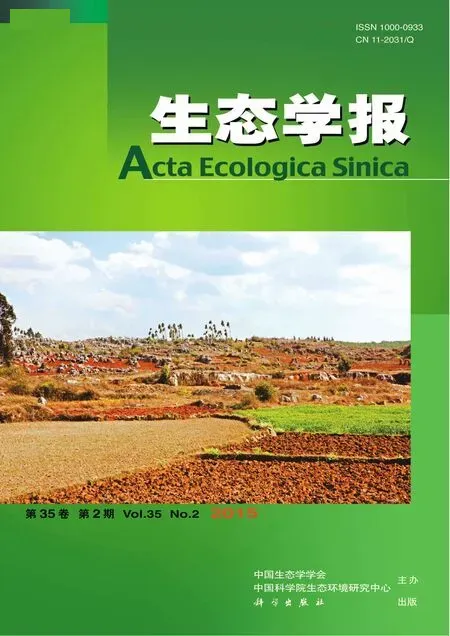基于线粒体DNA控制区的石鸡华北亚种的种群历史动态研究
宋 森, 王小立, 周 蓉, 王 莹, 刘迺发,*
1 兰州大学生命科学学院,兰州 730000 2 南阳师范学院生命科学与技术学院,南阳 473061
基于线粒体DNA控制区的石鸡华北亚种的种群历史动态研究
宋 森1, 王小立2, 周 蓉1, 王 莹1, 刘迺发1,*
1 兰州大学生命科学学院,兰州 730000 2 南阳师范学院生命科学与技术学院,南阳 473061
隶属于鸟纲鸡形目雉科的石鸡是一个多型种,在我国已有7个亚种被报道,其中石鸡华北亚种是我国的特有鸟。用石鸡华北亚种(Alectorischukarpubescens)12个地理种群112个样本的线粒体DNA控制区(mtDNA CR)1154 bp序列的信息研究了石鸡华北亚种的种群历史动态。112个样本中共发现28个变异位点,定义了29种单倍型,其中12个地理种群的50个样本共享单倍型H1,8个地理种群的16个样本共享单倍型H4。地理种群间存在较大的基因流,且种群间没有由于地理距离产生隔离的证据。负的Tajima(D=-1.336,P<0.05)和Fu(Fs=-1. 720,P<0.05)统计检验值及错配分布的单峰模式都支持石鸡华北亚种经历了种群扩张。石鸡华北亚种大部分种群的错配分布与种群过去的扩张相一致,扩张发生在晚更新世中期的第五寒冷期(0.027—0.06 Ma)。推测其扩张的原因可能为:1)更新世期间我国北方地区没有发生大规模的冰川,2)青藏高原的隆升使我国北方干旱化和荒漠化加剧利于石鸡种群的扩散。武都(WD)位于东洋界,而石鸡是典型的古北界的鸟种,表明WD种群可能是石鸡在东洋界的一个建群种,因此需要给予充分的关注。
石鸡; 线粒体DNA; 基因流; 种群扩张; 种群动态
随着似然法和溯祖法[1- 4]与传统的种群遗传法[5- 6]应用于基于单倍型分布的地理模式的研究,研究者可以对有关种群进化如隔离、瓶颈效应、种群扩张、基因流和种群的分化程度等进行推测。而种群历史的许多方面可以从DNA序列中进行推测[7- 8]。对DNA序列进行系统遗传分析时会产生一棵树,当把种群地理分布的信息附加到这棵树上时,就会显示出种群是经历了一个隔离的、随机交配的或者是部分联合的历史。例如,不同地点或区域的单倍型可能互为单系群,表明这些种群经历了一个隔离的历史。溯祖分析可以进一步的显示出种群增长和基因流的规模与方向的信息[9- 10]。
石鸡(Alectorischukar)分布广泛,从巴尔干半岛东部及地中海附近岛屿到中亚至我国东北均有分布[11- 14],具有重要的经济价值[15]和科研价值[16]。石鸡亚种分化众多,在我国已报导的就有7个亚种[17]。石鸡华北亚种(Alectorischukarpubescens)为我国的特有亚种,分布于辽宁西部、河北、北京西山、山西、内蒙古东南部、山东半岛、江苏云台山、安徽北部和四川北部[18]、甘肃东部和南部、陕西北部[11,19- 20]。近几年,对石鸡的研究主要集中在以下几个方面:生活史[21- 23],系统地理[24]、渐渗杂交[25- 31]和遗传结构与保护[16,32- 34]。
本文以我国石鸡华北亚种12个地理种群112个样本为材料,通过对石鸡线粒体DNA控制区1154 bp序列遗传信息的分析来探讨石鸡华北亚种的种群历史动态。
1 材料和方法
1.1 样本采集与DNA提取、扩增和测序
从12个地点采集到112个石鸡肌肉或肝脏样本(表1和图1)。采集的样本置于95%的乙醇中带回实验室后放在-20℃冰柜中保存。组织样本用蛋白酶K消化后采用标准的苯酚-氯仿法[35]提取总DNA。引物PHDL(5′-AGGACTACGGCTTGAAAAGC- 3′)[36]和PH1H(5′-TTATGTGCTTGACCGA GGAACCAG- 3′)[37]用于对线粒体DNA控制区Ⅰ区和部分Ⅱ区的序列进行扩增和测序,L400(5′-ATTTATTGATCGTCCACCTCACG- 3′)[37]和PHDH(5′-CATCTTGGCATCTTCAGTGCC- 3′)[36]用于对线粒体DNA控制区部分Ⅱ区和Ⅲ区的序列进行扩增和测序。测序模板的制备:PCR反应体积为50 μL,反应液中含 10 mmol/L Tris-HCl,pH 8.3,50 mmol/L KCl,1.5 mmol/L MgCl2,Taq酶1U,4种dNTP各150 μmol/L,两个引物各10 pmol/L,DNA模板约100 ng。反应在PE9700型PCR仪上进行。循环参数为95℃预变性4 min,然后95℃变性40 s,56℃退火40 s,72℃延伸60 s,共 35个循环,最后72℃后延伸10 min补齐。序列测定由上海生工生物工程技术有限公司完成。
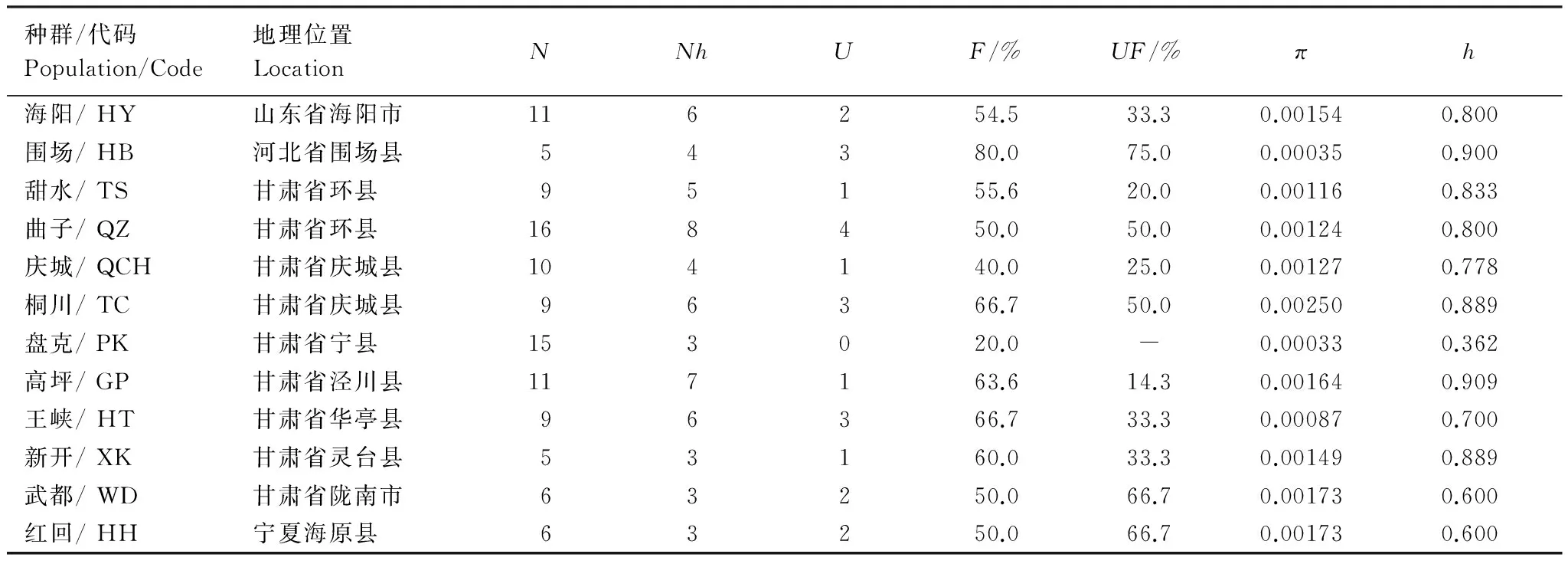
表1 石鸡华北亚种12个地理种群的单倍型信息及核苷酸与单倍型多样性Table 1 The information of the sampling sites and haplotypes, nucleotide and haplotype diversity of 12 chukar populations
N:样本量Number of samples;Nh:单倍型数Number of haplotypes;U:特有单倍型数Unique of haplotypes;F:单倍型频率Frequency of haplotypes;UF:特有单倍型频率Frequency of unique gaplotypes;h:单倍型多样性;π:核苷酸多样性
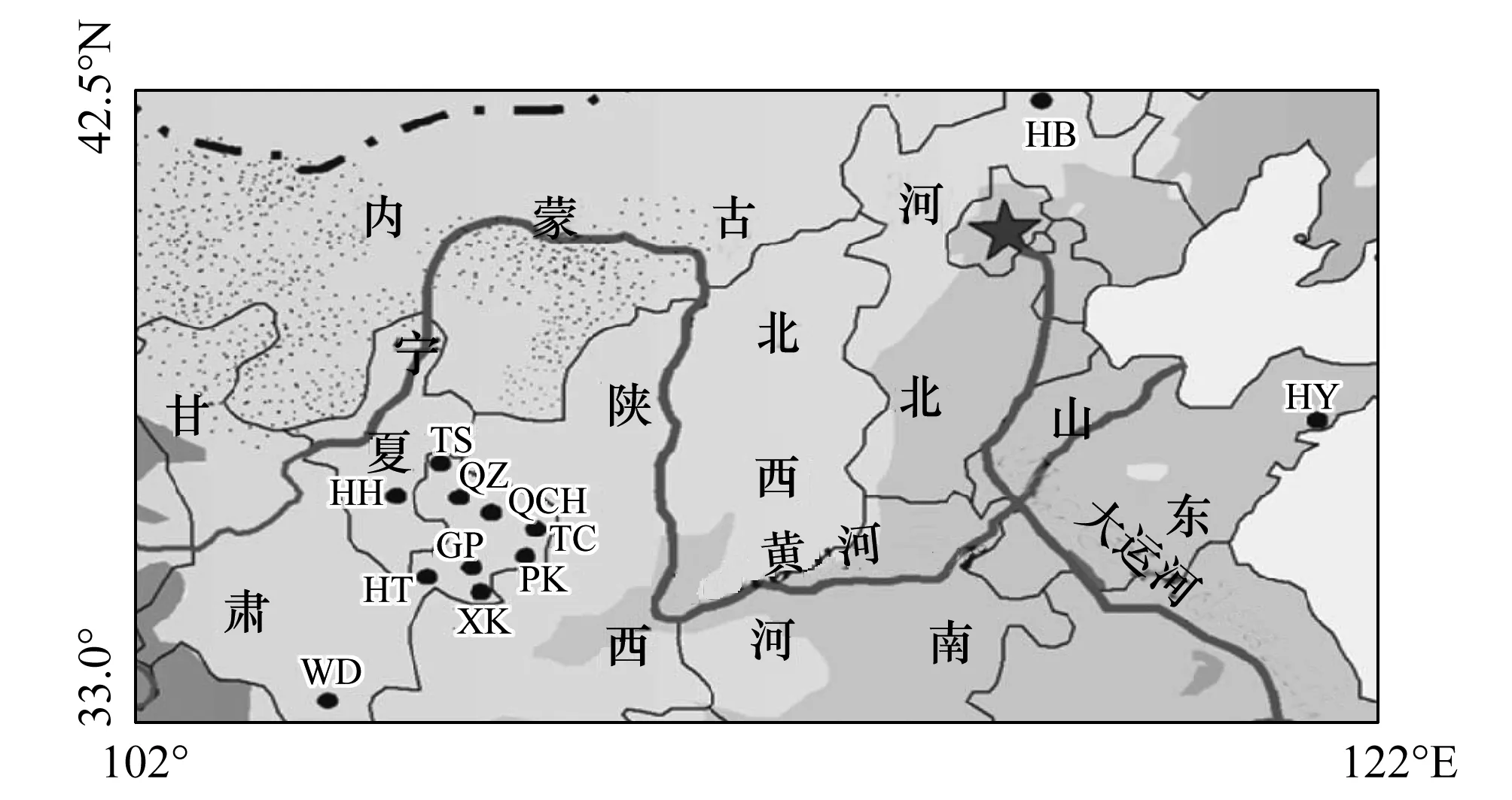
图1 采样点大致位置示意图(字母缩写代表的含义见表1) Fig.1 Map showing locations of sampling sites (The abbreviations see Table 1)
1.2 数据分析
对获得的每个样本的双向测序图谱用Conting软件进行拼接,并用Clustal W软件[38]对序列进行排列。用分子进化遗传分析软件MEGA4.0[39]计算遗传距离、碱基组成以及转换颠换比(R=Transition/Transvertion,R=Ti/Tv)。用软件DnaSP 5.0[40]筛选单倍型并计算单倍型多样性(h)和核苷酸多样性(π)并进行错配分布(Mismatch distributions)分析。用Arlequin3.0软件[41]计算种群分化系数(Fst)、基因流(Nem)、计算扩张时间的参数τ以及扩张前(θ0)与扩张后(θ1)的相对种群大小,用Arlequin3.0软件包中的选择性中性检验程序对石鸡华北亚种及各种群进行中性检验。同时用Arlequin3.0软件包[41]中的分子变异分析程序对石鸡华北亚种进行分子变异分析(Analysis of Molecular Variance,AMOVA),用Network 4.5.1.6(www.fluxus-engineering. com)软件构建单倍型网络图。
种群扩张时间的计算使用公式t=τ/2u(u为石鸡mtDNA控制区的突变速率)[42]。突变速率u按下面的步骤计算获得:首先使用公式d=(tv+tvR)/m(其中tv为石鸡和大石鸡序列间的颠换数,R为石鸡序列间转换与颠换的比率,m为石鸡mtDNA控制区序列的长度)计算出每个位点的核苷酸替代数,再用k=d/2T(T为石鸡和大石鸡的分歧时间,在北京周口店发现了早更新世时期石鸡的化石[43],据此本文使用T= 2.0-2.5 Ma作为石鸡和大石鸡粗略的分歧时间计算石鸡一个世系在一个位点每年的核苷酸替代速率,然后用l=kg(其中g为石鸡的世代时间)计算每个核苷酸位点一个世代的突变速率,每个单倍型的突变速率为u=ml。这一计算突变速率的方法在Randi等[44]和Huang等[45]的论文中也使用过。
2 结果
2.1 遗传变异与遗传结构
石鸡华北亚种mtDNA控制区1154 bp序列的碱基含量为:T 32.1%、C 27.4%、A 26.4%、G 14.1%。A和C比例明显高于G和T的比例,碱基含量显示出一定的偏歧性。112个样本mtDNA控制区全序列共有28个变异位点,定义了29种单倍型(占总样本量的25.9%)(表2),其中单倍型H1由12个地理种群的50个样本共享(占总样本量的44.6%),单倍型H4由8个地理种群的16个样本共享(占总样本量的14.3%)。曲子种群的单倍型数及特有单倍型数均最多,分别为8个和4个,盘克、新开、红回和武都种群的单倍型数最少都为3个且盘克种群无特有单倍型(表1)。围场种群的单倍型频率和特有单倍型频率都最高,盘克种群的都最低(表1)。
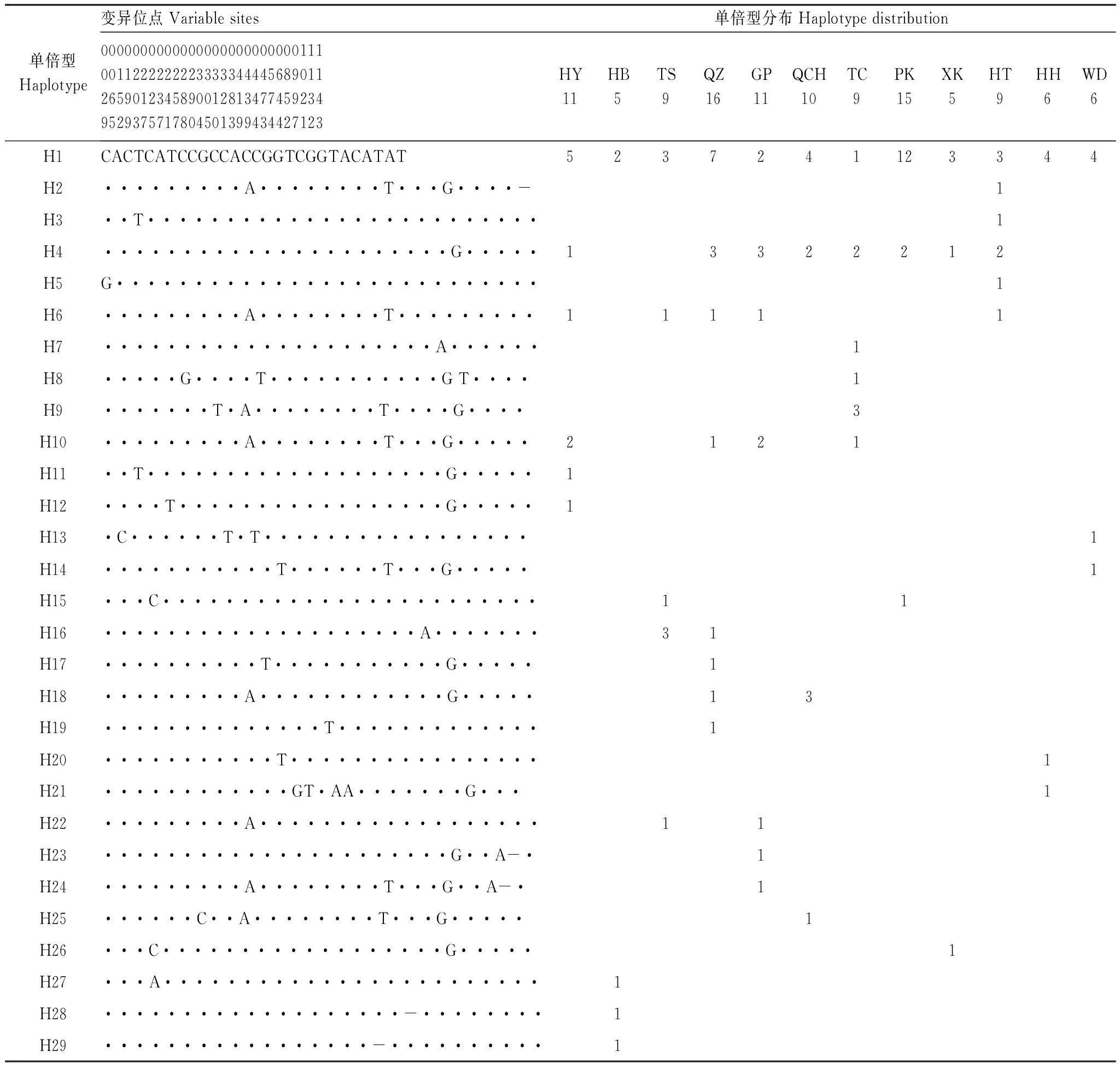
表2 石鸡华北亚种的单倍型分布及变异位点Table 2 Haplotype distribution and variable sites of A. c. pubescens
2.2 遗传多样性
所有样本的核苷酸多样性为0.00144,单倍型多样性为0.779(表1)。各种群中,高坪种群的单倍型多样性最高为0.909,其次为围场种群的0.900,盘克种群的单倍型和核苷酸多样性都最低,分别为0.362和0.00033,而桐川种群的核苷酸多样性最高为0.00250(表1)。AMOVA分析显示89.6%的变异发生在地理种群内,10.4%的变异发生在地理种群间。
2.3 种群扩张与基因流
对石鸡华北亚种全部样本的Fu′sFS检验和Tajima′sD检验(表3,图2)表明石鸡华北亚种接受种群扩张模型(Fu′sFs=-1.720,P<0.05;Tajima′sD=-1.336,P<0.05)。对各地理种群进行中性检验表明:HY(Tajima′sD=0.168,P>0.05)、QCH(Tajima′sD=0.143,P>0.05)和WD(Tajima′sD=0.243,P>0.05)拒绝种群扩张模型(但这3个地理种群的Fu′sFs值均为负值,分别为-1.867,P=0.097;-3.057,P= 0.036<0.05;-0.475,P=0.292),其余9个种群都接受种群扩张模型(表3)。各种群中PK种群的τ值最小,HH种群的τ值最大(表3)。大部分种群的错配分布(图3)与种群过去的扩张相一致。地理种群间有基因流(Nem)存在且种群间的基因流都较大,Nem值从0.751到无穷大(表4)。根据公式计算出的每个位点的核苷酸替代数d=0.048(tv=11,R=4.02,m=1154),根据化石发现时间,计算出的k的范围在0.98×10-8(T=2.50 Ma) 到 1.23×10-8(T=2.0 Ma)之间,同时假设石鸡的世代时间为2a,则每个时代突变速率的范围在1.96×10-8到2.45×10-8之间,相应地,每个单倍型的突变速率在2.26×10-5—2.83×10-5之间。根据这个突变速率计算得到的石鸡华北亚种各种群的扩张时间分别为:HY (0.042—0.052 Ma),TS和HB(0.027—0.033 Ma),QZ (0.027—0.034 Ma),QCH (0.027—0.034 Ma), TC (0.068—0.086 Ma),GP (0.041—0.052 Ma),XK (0.022—0.028 Ma),HT (0.033—0.041 Ma),HH (0.11—0.14 Ma),WD (0.071—0.089 Ma)。由此可以看出石鸡华北亚种各种群的扩张主要发生在0.027—0.053 Ma。
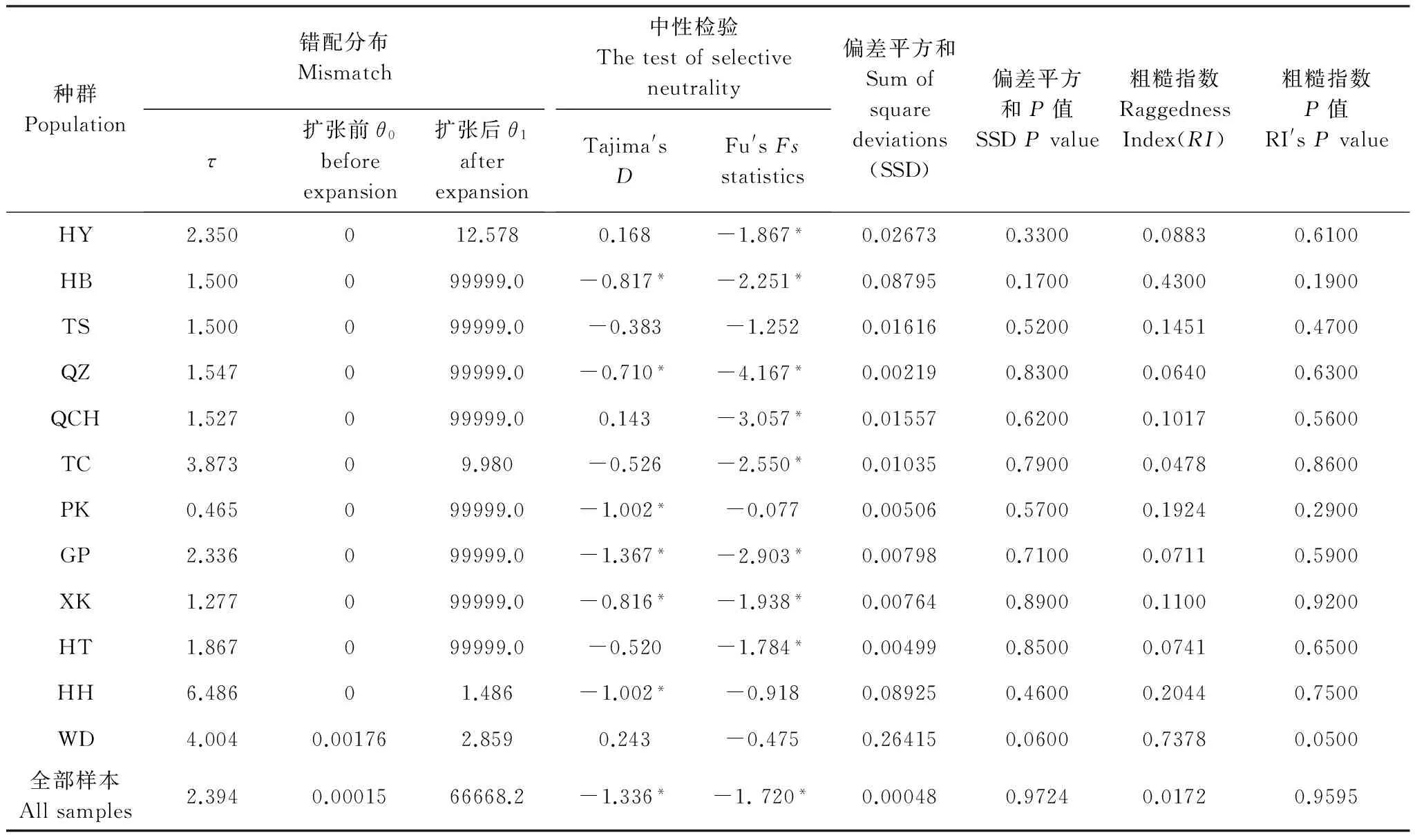
表3 错配分布、选择性中性检验、适合度及粗糙指数统计表Table 3 The statistics of mismatch analyses、the test of selective neutrality、SSD and Raggedness Index
*P<0.05,其余的P>0.05
2.4 中性检验
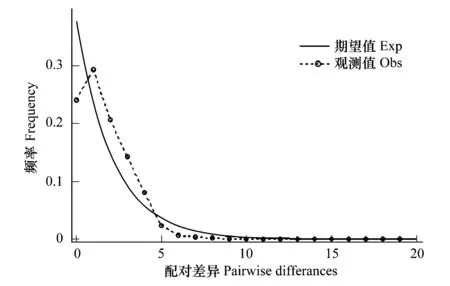
图2 突然扩张模型下石鸡华北亚种所有样本的错配分布图Fig.2 The observed pairwise difference and the expected mismatch distributions under the sudden expansion model of the control region haplotypes in A. c. pubescens
石鸡华北亚种12个地理种群中甜水(TS)、盘克(PK)、红回(HH)和武都(WD)种群的Fu′sFS值为非显著性负值(P>0.05),其余地理种群的Fu′sFS值均为负值且达显著水平(表3),这个结果表明稳定种群背离了中性进化或者种群经历了增长。除海阳、庆城和武都3个地理种群外其余9个地理种群的Tajima′sD值均为负值(表3)但华亭(HT)、桐川(TC)、甜水(TS)未达到显著。12个地理种群的统计检验并未显著偏离中性选择。错配分布及粗糙指数(Raggednessindex)表明,石鸡华北亚种大部分种群历史的变化趋向于种群增长模型(图3,表3)。
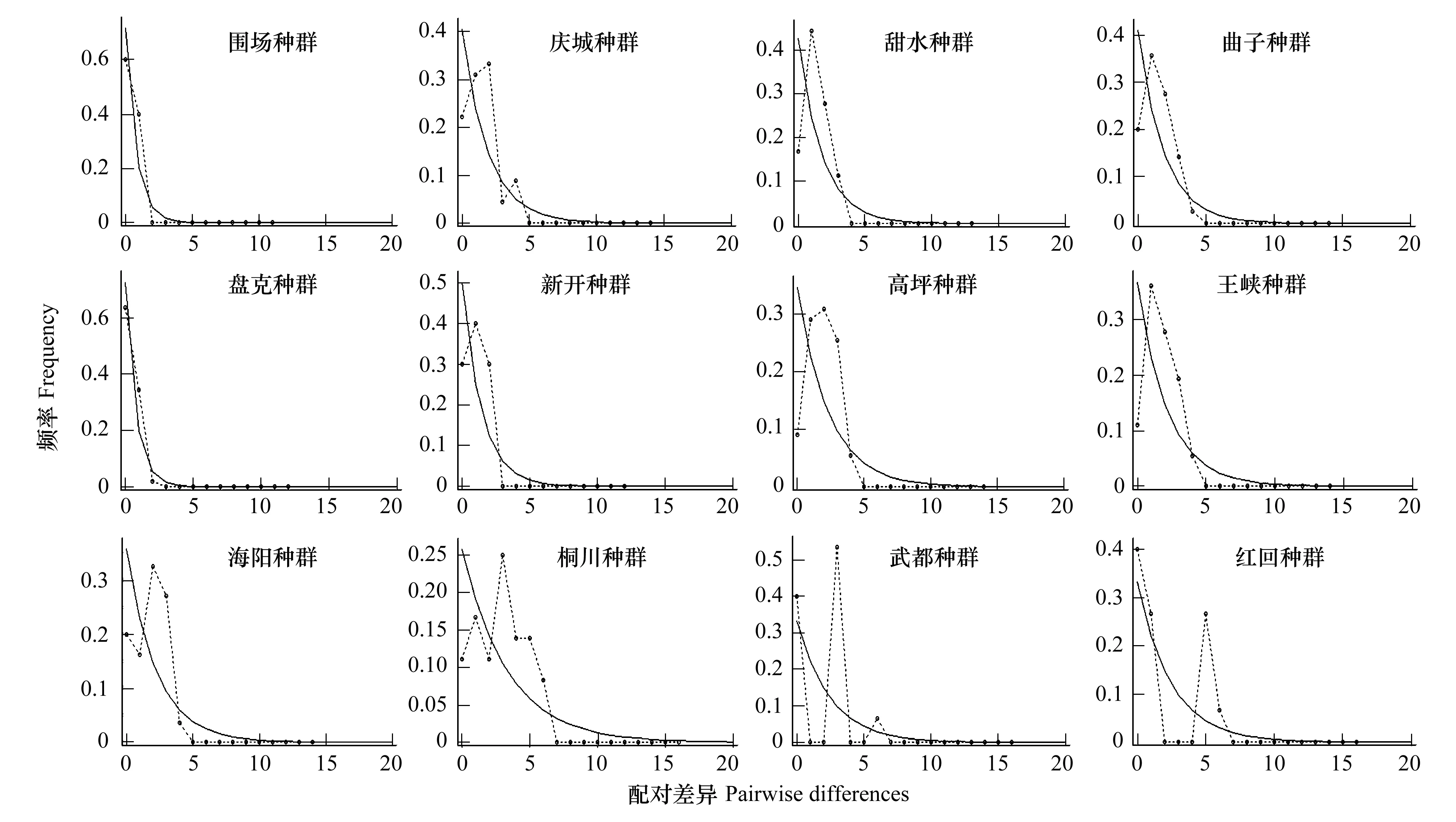
图3 突然扩张模型下石鸡华北亚种各地理种群错配分布图Fig.3 The observed pairwise difference and the expected mismatch distributions under the sudden expansion model for the 12 populations of A. c. pubescens
3 讨论
当在许多种群中都发现高的共享单倍型频率时,共享单倍型常为一个星状系统发生图的中心,这一情况意味着物种曾经从冰期避难地向外扩张[46]。低的遗传多样性(高的共享单倍型频率)通常是物种近来扩张到现今的分布范围或是在近期的历史中经历了瓶颈效应。相应的,具有高的遗传多样性(低的共享单倍型频率)表明种群有足够长的时间占领分布范围以积累突变。石鸡华北亚种12个地理种群50个样本共享单倍型H1,共享单倍型频率达44.6%,表明这些地理种群是近期由一个共同的祖先种群扩张而来。mtDNA控制区数据单倍型网络图(图4)显示出石鸡华北亚种星状系统发生图的中心为共享单倍型H1,表明石鸡华北亚种是由共同的祖先单倍型H1经扩散形成的。同时还有8个地理种群共享单倍型H4,相应的还有几个地理种群共享不同的单倍型(表2),该结果进一步说明石鸡华北亚种各种群间存在较大的基因流(表4)。
表4 石鸡华北亚种各种群间基因固定指数(上三角)与基因流(下三角)
Table 4 Population pairwise Fst-value (above the diagonal) and gene flow (below the diagonal) for comparisons between chukar populations
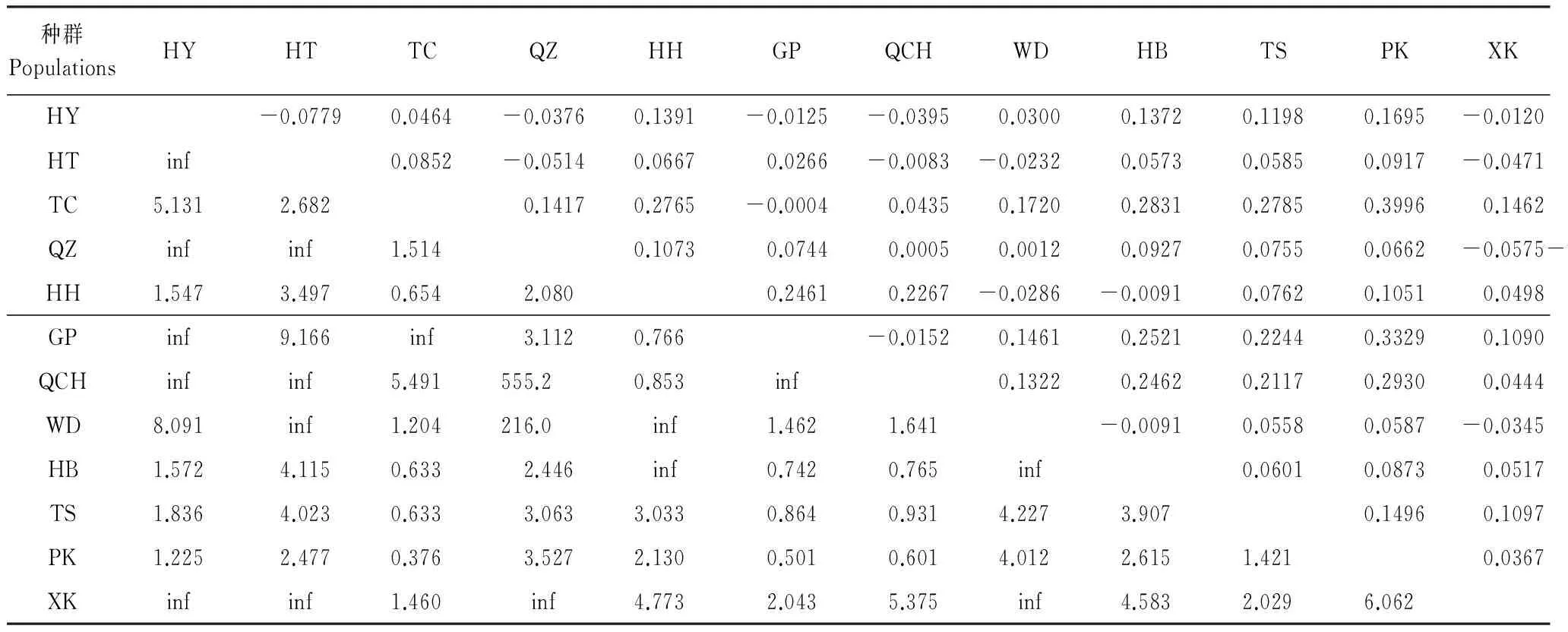
种群PopulationsHYHTTCQZHHGPQCHWDHBTSPKXKHY-0.07790.0464-0.03760.1391-0.0125-0.03950.03000.13720.11980.1695-0.0120HTinf0.0852-0.05140.06670.0266-0.0083-0.02320.05730.05850.0917-0.0471TC5.1312.6820.14170.2765-0.00040.04350.17200.28310.27850.39960.1462QZinfinf1.5140.10730.07440.00050.00120.09270.07550.0662-0.0575-HH1.5473.4970.6542.0800.24610.2267-0.0286-0.00910.07620.10510.0498GPinf9.166inf3.1120.766-0.01520.14610.25210.22440.33290.1090QCHinfinf5.491555.20.853inf0.13220.24620.21170.29300.0444WD8.091inf1.204216.0inf1.4621.641-0.00910.05580.0587-0.0345HB1.5724.1150.6332.446inf0.7420.765inf0.06010.08730.0517TS1.8364.0230.6333.0633.0330.8640.9314.2273.9070.14960.1097PK1.2252.4770.3763.5272.1300.5010.6014.0122.6151.4210.0367XKinfinf1.460inf4.7732.0435.375inf4.5832.0296.062
inf:表示无穷大
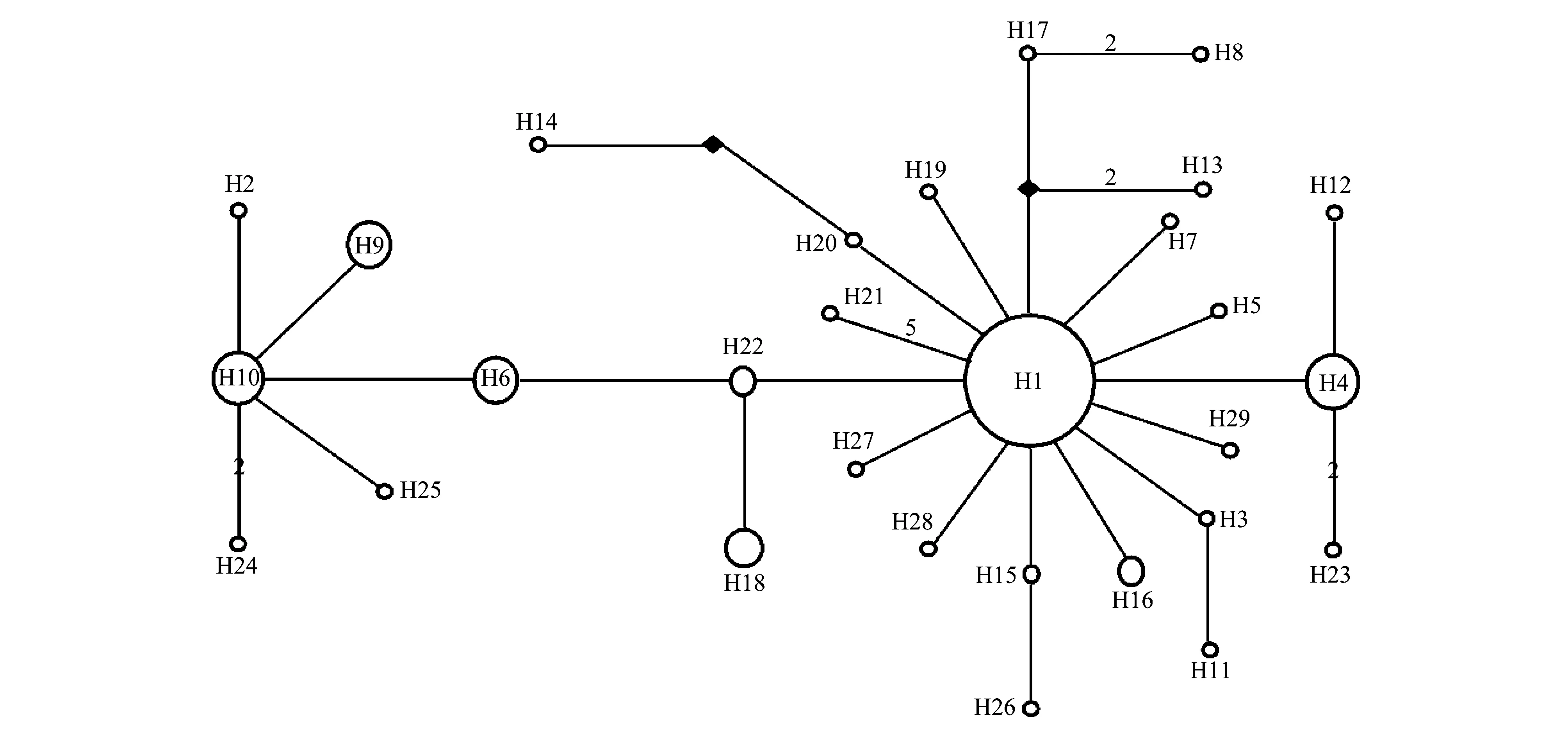
图4 根据石鸡华北亚种mtDNA 控制区所做单倍型网络图Fig.4 Haplotype network estimated from chukar control-region data. Small black squares indicated missing haplotypes that were not observed黑色棱方形代表缺失的单倍型; 圆圈大小代表单倍型频率,单倍型间数字代表突变数,未标明者均为1个突变
遗传多样性是物种长期进化过程中对环境变化产生的一种适应,在一定程度上反映了物种的进化潜力[47- 49]。根据石鸡华北亚种mtDNA控制区基因片段的差异,在112个个体中发现了29个单倍型,表现出较低的遗传多样性。群体中mtDNA核苷酸多样性(π值)是衡量群体多态程度的重要指标,π值越大,群体多样性程度越高[50]。与石鸡属的其它种如欧石鸡(Alectorisgraeca)[44]和大石鸡(Alectorismagna)[45]及其他鸟类[51- 53]的核苷酸多样性相比,石鸡华北亚种的核苷酸多样性(0.00144±0.00014)较低。低水平的核苷酸多样性出现的原因可能是:1)在更新世晚期和全新世,我国曾广泛发生泥石流[54]。在黄土区,包括秦岭以北出现频率低而强度大的暴雨泥石流[55],陇东黄土高原形成众多的沟壑。石鸡被宽阔的董志塬(2411 km2)隔离在环江和蒲河等大沟壑中;2)由于人类狩猎带来的强大的狩猎压力使得栖息在传统农牧区的石鸡种群数量不断下降;3)石鸡华北亚种主要分布在湿润的华北平原和半湿润的黄土高原地区,栖息生境的异质性较低。
较低的核苷酸多样性、较高频率的共享单倍型以及错配分布的单峰曲线都说明华北亚种的石鸡经历了近期种群扩张(表1,表3,图2)。根据扩张时间,石鸡华北亚种的扩张发生0.042—0.053 Ma,处在晚更新世中期的第五寒冷期(0.027—0.06 Ma)[56],也即中国东部大理冰期发生的时间。根据错配分布分析可知石鸡华北亚种的大部分种群经历了一个种群扩张的过程(表 3,图3),种群扩张发生在0.027—0.053 Ma,相当于晚更新世中期的第五寒冷期(0.027—0.06 Ma)[56]。这一时期,中国的气候特点是寒冷干旱,中国北方的森林植被发育状况较差,这样的生境适合适应干旱半干旱环境条件的石鸡生存。比较而言,桐川、武都和红回的石鸡种群增长较缓慢,相应的,这3个地理种群的扩张发生在晚更新世中期的第四温暖期(距今0.06—0.15 Ma)[56](表3),这一时期的气候特点是温暖湿润,森林灌丛植被发育良好,阻碍了石鸡种群的扩散。值得注意的是:图3中,武都种群和红回种群的观察值呈现出明显的双峰,表明这两个种群经历过瓶颈效应,推测其原因可能为:1)这两个种群处于石鸡分布范围的边缘,由于分布区的地形而与其它种群隔离的程度较大,尤其是武都种群与其它种群被四周的山地隔离;2)武都位于东洋界,而石鸡是典型的古北界的鸟种,说明石鸡武都种群可能是东洋界的一个建群种,这个建群种受到当地气候和环境条件的制约而处于瓶颈效应期;3)红回种群可能受到16世纪中期固原大地震和1920年海原大地震的影响,地震使得红回石鸡种群数量急剧下降,至今仍未恢复,种群处于瓶颈效应期。
中性检验得到各种群的Fu′s-Fs及Fs-P值,该数值表示种群在近期有无扩张趋势[57],结果发现石鸡华北亚种整体的Fs值为-1.720 (P<0.05),但各地理种群中除HH、WD、TS、PK有扩张的趋势但未达到显著(P>0.05),其余种群表现出显著地扩张趋势(P<0.05)(表3)。但Tajima′sD值显示HH种群和WD种群趋于稳定,没有扩张的趋势,这与这两个种群经历过瓶颈效应相一致。应用DnaSP分析软件进行错配分布检测,表明石鸡在进化历史部分地理种群发生过种群扩张,经历过种群增长过程,而不是处于种群稳定状态(图3)。
致谢:周天林、黄祖豪、张立勋、包新康、廖继承、杨志松和王留臣在样本收集中给予帮助,特此致谢。
[1] Beerli P, Felsenstein J. Maximum-lilkelihood eatimation of a migration rates and effective population numbers in two populations using a coalescent approach. Genetics, 1999, 152(2): 763- 773.
[2] Harpending H C, Batzer M A, Gurven M, Jorde L B, Rogers A R, Sherry S T. Genetic traces of ancient demography. Proceeding of the National Academy of Sciences of the United States of America, 1998, 95(4): 1961- 1967.
[3] Rogers A R. Genetic evidence for a Pleistocene population explosion. Evolution, 1995, 49: 609- 615.
[4] Ray N, Currat M, Excoffier L. Intra-deme molecular diversity in spatially expanding populations. Molecular Biology and Evolution, 2003, 20(1): 76- 86.
[5] Wright S. The genetical structure of populations. Ann. Eugenics, 1951, 15(1): 323- 354.
[6] Neigel J E. IsFSTobsolete?. Conservation Genetics, 2002, 3: 167- 173.
[7] Avise J C. Phylogeography: The History and Formation of Species. London: Harvard University Press, 2000.
[8] Nee S, Holmes E C, Rambuat A, Harvey P H. Inferring population history from molecular phylogenies // Harvey P H, Leigh Brown A J, Maynard Smith J, Nee S, eds. In New Uses for New Phylogenies. New York: Oxford University Press, 1996: 399- 411.
[9] Hewitt G M. Some genetic consequences of ice ages, and their role in divergence and speciation. Biological Journal of the Linnaean Society, 1996, 58(3): 247- 276.
[10] Templeton A R. Nested clade analyses of phylogeographic data: testing hypotheses about gene flow and population history. Molecular Ecology, 1998, 7(4): 381- 397.
[11] 郑作新. 中国动物志——鸟纲第四卷鸡形目. 北京: 科学出版社, 1978: 61- 66.
[12] Aebischer N. Alectoris chukar // Hagenmeijer E J M, Blair M J, eds. The EBCC Atlas of European Breeding Birds: Their Distribution and Abundance. London: T & AD Poyser, 1997.
[13] Madge S, McGowan P. Pheasants, Partridges and Grouse: A Guide to the Pheasants, Partridges, Quails, Grouse, Guineafowl, Buttonquails and Sandgrouse of the World. London: Christopher Helm, 2002.
[14] Clements J F. The Clements Checklist of Birds of the World. 6th ed. New York: Cornell University Press, 2007.
[15] 王香亭. 甘肃脊椎动物志. 兰州: 甘肃科技出版社, 1991: 387- 395.
[16] Randi E, Alkon P U. Genetic structure of Chukar (Alectorischukar) populations in Israel. The Auk, 1994, 111(2): 416- 426.
[17] 郑作新. 中国鸟类种和亚种分类名录大全 (第二版). 北京: 科学出版社, 2004.
[18] 李湘涛. 中国鸡形目鸟类种与亚种的分布和生存现状. 动物学报, 1996, 42 (增刊): 25- 30.
[19] Liu N F. Ecological investigation of chukar partridge in Northwest China. Annual Review of WPA, 1996: 44- 48.
[20] 郑光美. 中国鸟类分类与分布名录(第二版). 北京:科学出版社, 2011.
[21] 马新年, 杨志松, 刘迺发, 金园庭. 石鸡繁殖期栖息地的特征. 动物学杂志, 2006, 41(3): 1- 6.
[22] 周晓禹, 王晓明, 姜振华. 贺兰山石鸡越冬期栖息地的选择. 东北林业大学学报, 2008, 36(4): 32- 33, 39- 39.
[23] 周晓禹, 王晓明, 姜振华. 贺兰山石鸡越冬期昼间行为时间分配及活动规律. 东北林业大学学报, 2008, 36(5): 44- 46.
[24] Huang Z H, Liu N F. Molecular phylogeographic structure of chukar partridge (Alectorischukar) in the Loess Plateau of eastern Gansu, China. Acta Zoologica Sinica, 2004, 50(4): 576- 582.
[25] Chen Q, Chang C, Liu N F, Randi E, Lucchini V. Mitochondrial DNA introgression between two partridge species ofAlectoris. Acta Zoologica Sinica, 1999, 45(4): 456- 463.
[26] Liu N F, Wen L Y, Huang Z H, Hou P. Introgressive hybridization betweenAlectorismagnaand Alectoris chukar in the Liupan Mountain Region. Acta Zoologica Sinica, 2006, 52(1): 153- 159.
[27] Barilani M, Bernard-Laurent A, Mucci N, Tabarroni C, Kark S, Garrido J A P, Randi E. Hybridisation with introduced chukars (Alectorischukar) threatens the gene pool integrity of native rock (A.graeca) and red-legged (A.rufa) partridge populations. Biological Conservation, 2007, 137(1): 57- 69.
[28] Barilani M, Sfougaris A, Giannakopoulos A, Mucci N, Tabarroni C, Randi E. Detecting introgressive hybridisation in rock partridge populations (Alectorisgraeca) in Greece through Bayesian admixture analyses of multilocus genotypes. Conservation Genetics, 2007, 8(2): 343- 354.
[29] Barbanera F, Guerrini M, Hadjigerou P, Panayides P, Sokos C, Wilkinson P, Khan A A, Khan B Y, Cappelli F, Dini F. Genetic insight into Mediterranean chukar (Alectorischukar, Galliformes) populations inferred from mitochondrial DNA and RAPD markers. Genetics, 2007, 131(3): 287- 298.
[30] Barbanera F, Guerrini M, Khan A A, Panayides P, Hadjigeron P, Sokos C, Gombobaatar S, Samadi S, Khan B Y, Tofanelli S, Paoli G, Dini F. Human-mediated introgression of exotic chukar (Alectorischukar, Galliformes) genes from east Asia into native Mediterranean partridges. Biological Invasion, 2009, 11(2): 333- 348.
[31] 杨志松, 刘迺发. 基于细胞色素b基因研究两种石鸡间的渐渗杂交. 重庆师范大学学报: 自然科学版, 2009, 26(4): 32- 37.
[32] Huang Z H, Liu N F. Genetic structure of chukar partridge (Alectorischukar) populations in the Longdong Loess Plateau, China. Journal of Ornithology, 2004, 145(2): 137- 141.
[33] Barbanera F, Marchi C, Guerrini M, Panayides P, Sokos C, Hadjigerou P. Genetic structure of Mediterranean chukar (Alectorischukar, Galliformes) populations: conservation and management implications. Naturwissenschaften, 2009, 96(10): 1203- 1212.
[34] Guerrini M, Panayides P, Hadjigerou P, Taglioli L, Dini F, Barbanera F. Lack of genetic structure of CypriotAlectorischukar(Aves, Galliformes) population as inferred from mtDNA sequencing data. Animal Biodiversity of Conservation, 2007, 30(1): 105- 114.
[35] Sambrook J, Fritsch E F, Maniatis T. Molecular Cloning: A Laboratory Manual. 2nd ed. New York: Cold Spring Harbor Laboratory Press, 1989.
[36] Fumihito A, Miyake T, Takada M, Ohno S, Knodo N. The genetic link between the Chinese bamboo partridge (Bambusicolathoracica) and the chicken and junglefowls of the genusGallus. Proceeding of the National Academy of Sciences of the United States of American, 1995, 92(24): 11053- 11056.
[37] Randi E, Lucchini V. Organization and evolution of the mitochondrial DNA control region in the avian genusAlectoris. Journal of Molecular Evolution, 1998, 47(4): 449- 462.
[38] Thompson J D, Gibson T J, Plewniak F, Jeanmougin F, Higgins D G. The CLUSTAL_X windows interface flexible strategies for multiple sequence alignment aided by quality analysis tool. Nucleic of Acid Research, 1997, 25(24): 4876- 4882.
[39] Tamura K, Dudley J, Nei M, Kumar S. MEGA4: Molecular Evolutionary Genetics Analysis (MEGA) software version 4. 0. Molecular Biology and Evolution, 2007, 24(8): 1596- 1599.
[40] Librado P, Rozas J. Dnasp v5: A software for comprehensive analysis of DNA polymorphism data. Bioinformatics, 2009, 25(11): 1451- 1452.
[41] Excoffier L, Laval G, Schneider S. Arlequin ver. 3. 0: An integrated software package for population genetics data analysis. Evolution Bioinformatics Online, 2005, 1: 47- 50.
[42] 侯连海. 周口店更新世鸟类化石. 古脊椎动物与古人类, 1982, 20(4): 366- 368.
[43] Hou L H. Brief report on “Avian fossils of Pleistocene from Zhoukoudian, China”. Vertebrata Palasiatica, 1982, 20(4): 366- 368.
[44] Randi E, Tabarroni C, Rimondi S, Lacchini V, Sfougaris A. Phylogeography of the rock partridge (Alectorisgraeca). Molecular Ecology, 2003, 12(8): 2201- 2214.
[45] Huang Z H, Liu N F, Luo S X, Long J. Phylogeography of rusty-necklaced partridge (Alectorismagna) in northwestern China. Molecular Phylogenetics and Evolution, 2007, 43(2): 379- 385.
[46] Kvist L, Martens J, Higuchi H, Nazarenko A A, Valchuk O P, Orell M. Evolution and genetic structure of the great tit (Parusmajor) complex. Proceedings of the Royal Society of London Series B-Biological Sciences, 2003, 270(1523): 1447- 1454.
[47] Frankel O H, Soule M E. Conservation and Evolution. Cambridge: Cambridge University Press, 1981.
[48] McNeely J A, Miller K R, Reid W V, Mitermeier R A, Werner T B. Conservingthe World′s Biological Diversity. Washington: IUCN, World Resources Institute, Conservation International, WWF-US and the World Bank, 1990.
[49] Humphries C J, Williams P H, Vane-Wright R I. Measuring biodiversity value for conservation. Annual Review of Ecology and Systematics, 1995, 26(1): 93- 111.
[50] Avise J C, Ball R M, Arnold J. Current versus historical population sizes in vertebrate species with high gene flow: a comparison based on mitochondrial DNA lineages and inbreeding theory for neutral mutations. Molecular Biology and Evolution, 1988, 5(4): 331- 344.
[51] Qu J Y, Liu N F, Bao X K, Wang X L. Phylogeography of the ring-necked pheasant (Phasianuscolchicus) in China. Molecular Phylogenetics and Evolution, 2009, 52(1): 125- 132.
[52] Qu Y H, Lei F M, Zhang R Y, Lu X. Comparative phylogeography of five avian species: implications for Pleistocene evolutionary history in the Qinghai-Tibetan plateau. Molecular Ecology, 2010, 19(2): 338- 351.
[53] 崔之久, 谢又予, 熊黑钢, 曾思伟. 浅谈中国第四纪泥石流历史与沉积环境 // 中国西部第四纪冰川与环境研究中心.中国西部第四纪冰川与环境. 北京: 科学出版社, 1991: 254- 263.
[54] Cui Z J, Xie Y Y, Xiong H G, Zeng S W. The History of Debris Flow and Depositional Environment during Quaternary in China // The Research Center of Quaternary Glaciation and Environment. The Quaternary Glaciation and Environment of Western China. Beijing: Science Press, 1991: 254- 263.
[55] Du R H, Kang Z C. Debris flows and their countermeasure in China // Proceedings of the Japan-China Symposium on Landslides and Debris Flows. Niigata, Tokyo, Japan, 1989: 191- 194.
[56] 曹兴山. 甘肃第四纪气候期划分. 干旱区研究, 1996, 13(3): 28- 40.
[57] Fu Y X. Statistical tests of neutrality of mutations against population growth, hitchhiking and background selection. Genetics, 1996, 147(2): 915- 925.
Demographic history ofAlectorischukarpubescensbased on mitochondrial DNA control region
SONG Sen1, WANG Xiaoli2, ZHOU Rong1, WANG Ying1, LIU Naifa1,*
1SchoolofLifeSciences,LanzhouUniversity,Lanzhou730000,China2SchoolofLifeScienceandTechnology,NanyangNormalUniversity,Nanyang473061,China
The chukar partridge (Alectorischukar, Aves, Galliformes) is a polytypic species, with 17 described subspecies globally. Chukar partridge has a very wide distribution, ranging from east Balkans and the adjacent Mediterranean islands to central Asia and up into northeastern China. There are seven described subspecies in China:A.c.pubescens,A.c.potanini,A.c.ordoscensis,A.c.pallida,A.c.falki,A.c.dzungaricaandA.c.pallescens. Of the seven subspecies,A.c.pubescensandA.c.pallidaare endemic to China. The region which chukar partridges inhabit includes two distinct climatic types, the arid and semi-arid climate region in the west and temperate monsoon region in the east in China. Chukar partridge is a very important hunting bird in northern China. Currently, populations of chukar partridges in this desert area are threatened by hunting pressure and human persecution on the desert area of northern China. Previous studies have focused on the following aspects, such as phylogeography, introgression and genetic structure. These studies sought to address the scarcity of demographic information on chukars, in particular the subspecies endemic to China,A.c.pubescensandA.c.pallida. The present study employed a direct sequencing method to investigate the past demographic changes in 112A.c.pubescensspecimens sampled from 12 populations. A total of 1154-bp sequences of mitochondrial DNA control region data were sequenced, and 28 polymorphic sites defined 29 haplotypes. The most common haplotype, H1, was shared by 50 samples from 12 populations and the second most common haplotype, H4, was shared by 16 samples which came from eight populations. The gene flow estimate revealed that high gene flow occurs among the 12 populations. No evidence of isolation by geographic distance among the populations was observed. The combination of low nucleotide and high haplotype diversity, and the shape of the mismatch distributions both suggest thatA.c.pubescenshas undergone a recent population expansion. The recent expansion hypothesis is also supported by the common haplotypes (H1 and H4) shared between geographically distinct regions and by the non-significant mismatch distribution analysis indicating a demographic population expansion. Neutrality tests also suggested thatA.c.pubescenshas undergone a population expansion. The combination of a negative Tajima′s D (D=-1.336,P<0.05), Fu′sFs(Fs=-1.720,P<0.05), and a unimodal of mismatch distributions ofA.c.pubescensare consistent with past population expansion. Our results revealed that mostA.c.pubescenspopulations experienced population expansion during 0.027—0.06 Ma. Based on the expansion time, we speculate that the expansion of the chukar, occurring in the metaphase of the late Pleistocene (the fifth cold period), may have resulted from two reasons: 1) there were no large-scale glacier effect in north China during Pleistocene, 2) the uplift of the Qinghai-Tibet Plateau resulted in the aggravation of the drought and desertification, both of which are suitable for population expansion of chukar partridge. The chukar partridge inhabits Palearctic regions; however, the WD population, located in the Oriental realm, may have been a founder population in this region. Therefore, this particular population should be treated as a stand-alone management unit and further investigations into its ecology should be carried out.
Alectorischukar; mitochondrial DNA; gene flow; population expansion; population demography
国家自然科学基金项目(30530130, 41071031); 教育部博士点基金(新教师类)(2012021110200040); 兰州大学中央高校基本科研业务费专项基金(lzujbky- 2012- 119)
2013- 03- 22;
日期:2014- 03- 25
10.5846/stxb201303220487
*通讯作者Corresponding author.E-mail: naifaliu@sohu.com
宋森, 王小立, 周蓉, 王莹, 刘迺发.基于线粒体DNA控制区的石鸡华北亚种的种群历史动态研究.生态学报,2015,35(2):280- 289.
Song S, Wang X L, Zhou R, Wang Y, Liu N F.Demographic history ofAlectorischukarpubescensbased on mitochondrial DNA control region.Acta Ecologica Sinica,2015,35(2):280- 289.
——和田盘羊

